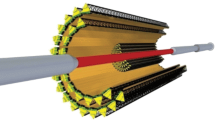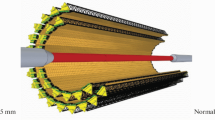Abstract
Improving the accuracy of reconstruction of the decay vertices of short-lived particles plays a fundamental role in the heavy-flavor sector of the MPD physics program. The MPD inner tracking system (ITS) based on a new generation of silicon detectors,—monolithic active pixel sensors (MAPS)—would certainly offer new possibilities within the scope of charm particle detection. A quality assessment of the MPD tracking system including ITS and time projection chamber (TPC), when reconstructing the decays of D‑mesons produced in central Au + Au collisions at \(\sqrt {{{s}_{{NN}}}} \) = 9 GeV has been performed in the course of computer simulations in the Mpdroot framework. The selection of D-meson signals in the invariant mass spectrum of their decay products was performed using a toolkit for multivariate data analysis.




Similar content being viewed by others
REFERENCES
Kh. U. Abraamyan et al., “The MPD detector at the NICA heavy-ion collider at JINR,” Nucl. Instrum. Methods Phys. Res., Sect. A 628, 99–102 (2011).
B. Mueller, “Hadronic signals of deconfinement at RHIC,” Nucl. Phys. A 750, 84–97 (2005).
G. D. Moore and D. Teaney, “How much do heavy quarks thermalize in a heavy ion collisions,” Phys. Rev. C 71, 064904 (2005).
H. Hees and R. Rapp, “Thermalization of heavy quarks in the quark-gluon plasma,” Phys. Rev. C 71, 034907 (2005).
B. Abelev et al., “Technical design report for the upgrade of the ALICE inner tracking system,” J. Phys. G: Nucl. Part. Phys. 41, 08700 (2014).
A. I. Zinchenko, S. N. Igolkin, V. P. Kondratiev, and Yu. A. Murin, “NICA-MPD vertex tracking detector identification capability for reconstructing strange and charmed particle decays,” Phys. Part. Nucl. Lett. 17, 856 (2020).
MpdRoot Software. http://git.jinr.ru/nica/mpdroot.
A. N. Tawfik and E. Abbas, “Thermal description of particle production in Au–Au collisions at RHIC energies (STAR),” Phys. Part. Nucl. Lett. 12, 521 (2015).
S. G. Mashnik and A. J. Sierk, “User manual for the code LAQGSM,” Report LA-UR-01-6804 (Los Alamos Natl. Labor., Los Alamos, 2001).
A. Hoecker, P. Speckmayer, J. Stelzer, J. Therhaag, E. von Toerne, and H. Voss, “TMVA4—toolkit for multivariate data analysis with ROOT,” arXiv:physics/0703039v5 [physics.data-an] (2009).
W. Cassing, E. L. Bratkovskaya, and A. Sibirtsev, “Open charm production in relativistic nucleus-nucleus collisions,” Nucl. Phys. A 691, 753–778 (2001).
Funding
This work was supported by grant no. 18-02-40119 from the Russian Foundation for Basic Research.
Author information
Authors and Affiliations
Corresponding author
Rights and permissions
About this article
Cite this article
Kondratiev, V.P., Maltsev, N.A. & Murin, Y.A. MPD ITS Physical Simulations with Focus on Charmed Mesons. Phys. Part. Nuclei 52, 737–741 (2021). https://doi.org/10.1134/S1063779621040353
Received:
Revised:
Accepted:
Published:
Issue Date:
DOI: https://doi.org/10.1134/S1063779621040353




